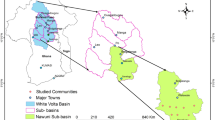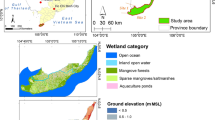Abstract
Tigris and Euphrates river basin (TERB) is one of the largest river basins in the Middle East, and the precipitation (in the form of snowfall) is a major source of streamflow. This study investigates the spatial and temporal variability of precipitation and streamflow in TERB to better understand the hydroclimatic variables and how they varied over time. The precipitation shows a decreasing trend with 1980s being wetter and 2000s being drier. A total of 55 and 40% reduction in high flows in Tigris and Euphrates rivers at T20 and E3 was seen in post-reservoir period. A lag time of 3 to 4 and 5 to 6 months was estimated between peak snowfall and runoff time periods. Decreasing precipitation and streamflow along with several planned dams could hamper the sustainability of several Mesopotamian marshlands that completely depend on the water from the Tigris and Euphrates rivers.










Similar content being viewed by others
References
Adger, W. N., Dessai, S., Goulden, M., Hulme, M., Lorenzoni, I., Nelson, D. R., Naess, L. O., Wolf, J., & Wreford, A. (2008). Are there social limits to adaptation to climate change? Climatic Change, 93(3–4), 335–354.
Ahmadi, M., Records, R., & Arabi, M. (2014). Impact of climate change on diffuse pollutant fluxes at the watershed scale. Hydrological Processes, 28(4), 1962–1972.
Al-Ansari, N., & Knutsson, S. (2011). Toward prudent management of water resources in Iraq. Journal of Advanced Science and Engineering Research, 1, 53–67.
Al-Ansari, N., Issa, E., & Knutsson, S. (2013). Nature of the Distributed of the Bed Sediment within Mosul Dam Reservoir, Iraq. 2nd Engineering Scientific Conference, Mosul University, Mosul, 19–20 November 2013.
Al-AnsariIssa, N. & Knutsson, E. (2014). Nature of the Distributed of the Bed Sediment within Mosul Dam Reservoir, Iraq. Al-Rafidain Engineering Journal.
Altinbilek, D. (2004). Development and management of the Euphrates–Tigris basin. International Journal of Water Resources Development., 20(1), 15–33.
Beaumont, P. (1998). Restructuring of water usage in the Tigris-Euphrates Basin: the impact of modern water management policies. Yale School of Forestry and Environmental Studies, Bulletin Series, 103, 168–186.
Bozkurt, D., & Sen, O. L. (2013). Climate change impacts in the Euphrates–Tigris Basin based on different model and scenario simulations. Journal of Hydrology, 480, 149–161.
Chen, Z., Kavvas, M., Ohara, N., & Anderson, M. L (2011). Coupled regional hydroclimate model and its application to the Tigris-Euphrates basin. Journal of Hydrologic Engineering, 16(12), 1059–1070. doi:10.1061/(ASCE)HE.1943-5584.
Chenoweth, J., Hadjinicolaou, P., Bruggeman, A., Lelieveld, J., Levin, Z., Lange, M. A., Xoplaki, E., & Hadjikakou, M. (2011). Impact of climate change on the water resources of the eastern Mediterranean and Middle East region: modeled twenty-first century changes and implications. Water Resources Research, 47(6), W06506.
Christensen, N. S., Wood, A. W., Voisin, N., Lettenmaier, D. P., & Palmer, R. N. (2004). The effects of climate change on the hydrology and water resources of the Colorado River basin. Climatic Change, 62(1–3), 337–363.
Cullen, H., Kaplan, A., & Arkin, P. (2002). Impact of the North Atlantic oscillation on middle eastern climate and streamflow. Climatic Change, 55(3), 315–338.
Daggupati, P., Srinivasan, R., Dile, Y. T., & Verma, D. (2016). Reconstructing the historical water regime of the contributing basins to the Hawizeh marsh: implications of water control structures. Science of the total environment. doi:10.1016/j.scitotenv.2016.12.029.
Diffenbaugh, N.S., Pal, J.S., Trapp, R.J., & Giorgi, F. (2005). Fine-scale processes regulate the response of extreme events to global climate change. Proceedings of the National Academy of Sciences of the United States of America, 102 (44), 15774–8.
Dile, Y., & Srinivasan, R. (2014). Evaluation of CFSR climate data for hydrologic prediction in data-scarce watersheds: an application in the Blue Nile River basin. JAWRA Journal of the American Water Resources Association, 50(5), 1226–1241.
Fuka, D.R., Walter, M. T., MacAlister, C., Degaetano, A. T., Steenhuis, T.S. & Easton, Z. M. (2013). Using the Climate Forecast System Reanalysis as Weather Input Data for Watershed Models. Hydrological Processes, doi: 10.1002/hyp.10073.
Gustard, A., Bullock, A., & Dixon, J. M. (1992). Low flow estimation in the United Kingdom. Wallingford: Institute of Hydrology Report 108.
Hallegatte, S., Hourcade, J.-C., & Dumas, P. (2007). Why economic dynamics matter in assessing climate change damages: illustration on extreme events. Ecological Economics, 62(2), 330–340. doi:10.1016/j.ecolecon.2006.06.006.
IPCC (2014a). Climate Change 2013: The Physical Science Basis. Geneva, Switzerland. Retrieved from http://www.ipcc.ch/report/ar5/wg1/.
IPCC (2014b). Climate Change 2014: Impacts, Adaptation and Vulnerability. Geneva, Switzerland. Retrieved from http://www.ipcc.ch/report/ar5/wg2/.
Issa, E., Al-Ansari, N., & Knutsson, S. (2013a). Changes in bed morphology of Mosul dam reservoir. Journal of Advanced Science and Engineering Research, 3(2), 86–95.
Issa, I., Al-Ansari, N., & Knutsson, S. (2013b). Sedimentation and new operational curves for Mosul dam, Iraq. Hydrological Sciences Journal., 58(7), 1456–1466.
Jones, C., Sultan, M., Yan, E., & Milewski, A. (2008). Hydrologic impacts of engineering projects on the Tigris–Euphrates system and its marshlands. Journal of Hydrology, 353(1–2), 59–75.
Katz, R. W., & Brown, B. G. (1992). Extreme events in a changing climate: variability is more important than averages. Climatic Change, 21(3), 289–302.
Kavvas, M. L., Chen, Z. Q., Anderson, M. L., Ohara, N., Yoon, J. Y., & Xiang, F. (2011). A study of water balances over the Tigris-Euphrates watershed. Physics and Chemistry of the Earth, 36, 197–203.
Lavers, D. A., Villarini, G., Allan, R. P., Wood, E. F., & Wade, A. J. (2012). The detection of atmospheric rivers in atmospheric reanalyses and their links to British winter floods and the large-scale climatic circulation. Journal of Geophysical Research: Atmospheres, 117(D20), 27.
Leavesley, G. H. (1994). Modeling the effects of climate change on water resources - a review. Climatic Change, 28(1–2), 159–177.
Lehner, B., Verdin, K., & Jarvis, A. (2008). New global hydrography derived from Spaceborne elevation data. Eos, Transactions American Geophysical Union, 89(10), 93.
Milly, P. C. D., Dunne, K. A., & Vecchia, A. V. (2005). Global pattern of trends in streamflow and water availability in a changing climate. Nature, 438(7066), 347–350.
Özdoğan, M. (2011). Climate change impacts on snow water availability in the Euphrates-Tigris basin. Hydrology and Earth System Sciences, 15(9), 2789–2803.
Quadro, M.F.L., Berbery, E.H., Silva Dias, M.A.F., Herdies, D.L., & Gonçalves, L.G.G. (2013). The atmospheric water cycle over South America as seen in the new generation of global reanalyses. In: AIP Conference Proceedings. 732–735.
Richard Chen, Z. Q., Kavvas, M. L., Ohara, N., Anderson, M. L., & Yoon, J. (2011). Impact of water resources utilization on the hydrology of Mesopotamian marshlands. Journal of Hydrologic Engineering, 16(12), 1083–1092. doi:10.1061/(ASCE)HE.1943-5584.0000208.
Saha, S., Moorthi, S., Pan, H-L., Wu, X., Wang, J., Nadiga, S., et al. (2010). The NCEP climate forecast system reanalysis. Bulletin of American Meteorological Society, 91(8), 1015–1057.
Saleh, D.K. 2010. Stream Gage Descriptions and Stream flow Statistics for Sites in the Tigris River and Euphrates River Basins, Iraq. Data Series 540, U.S. Department of Interior, U.S. Geological Survey.
Smith, R. A., & Kummerow, C. D. (2013). A comparison of in situ, reanalysis, and satellite water budgets over the upper Colorado River basin. Journal of Hydrometeorology, 14(3), 888–905.
UNEP, & Partow, H. (2001). The Mesopotamian marshlands: demise of an ecosystem early warning and assessment technical report, UNEP/DEWA/TR.01–3 rev. 1. Kenya: Division of Early Warning and Assessment United Nations Environment Programme Nairobi.
Wei, W., Jilong, C., & Ronghui, H. (2013). Water Budgets of Tropical Cyclones: Three Case Studies. Advances in Atmpsheric Sciences 30:468-484.
Acknowledgements
This study was supported by Royal Dutch Shell plc. The authors would like to thank Dhanesh Yeginanthan for his help on generating statistics needed for this paper.
Author information
Authors and Affiliations
Corresponding author
Rights and permissions
About this article
Cite this article
Daggupati, P., Srinivasan, R., Ahmadi, M. et al. Spatial and temporal patterns of precipitation and stream flow variations in Tigris-Euphrates river basin. Environ Monit Assess 189, 50 (2017). https://doi.org/10.1007/s10661-016-5752-y
Received:
Accepted:
Published:
DOI: https://doi.org/10.1007/s10661-016-5752-y




